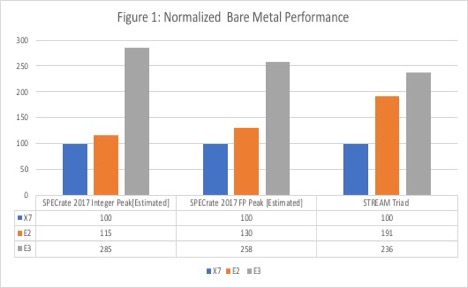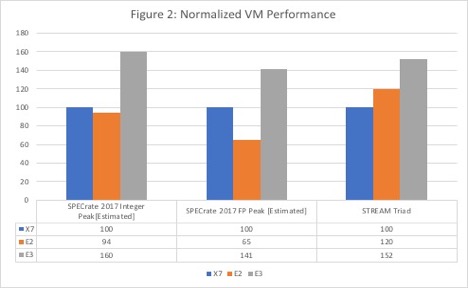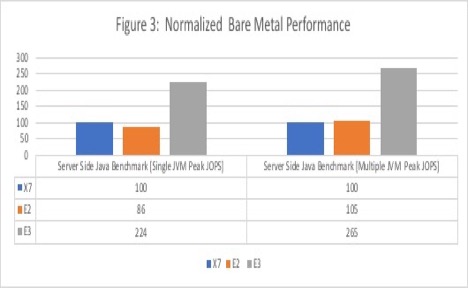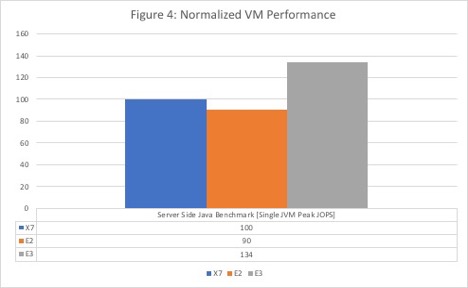Eighteen months ago, at Oracle OpenWorld 2018, we announced a strategic partnership with AMD and launched our first generation of Oracle Cloud Infrastructure Compute instances on first-generation AMD EPYC processors. Since that launch, we’ve deployed AMD E2 compute instances to all of our commercial regions. This has been a very successful product, and many of our enterprise customers and Oracle Cloud applications are running general-purpose workloads on AMD EPYC processors.
Today, I’m excited to announce the launch of Oracle Cloud Infrastructure Compute E3 Platform standard instances built on 2nd Gen AMD EPYC processors. These E3 standard instances are based on the AMD EPYC 7742 processor, with a base clock frequency of 2.25 GHz and max boost of up to 3.4 GHz. The bare metal E3 standard compute instance supports 128 OCPUs (128 cores, 256 threads) and 2 TB of RAM and has 100 Gbps of overall network bandwidth. This is the highest core count for a bare metal instance on any public cloud, and the memory bandwidth is well suited for both general-purpose and high-bandwidth workloads that require larger and faster memory.
Improvements
While our E2 instances have been very popular, we’ve actively listened to customer feedback and made the E3 instance even better in five key areas:
- E3 VM instances have a higher core count, with up to 64 OCPUs and 1 TB of memory.
- E3 instances have 16 GB of memory per OCPU—double the ratio of our current AMD E2 shapes.
- You’re free to select the exact number of OCPUs that you need for a VM—you’re no longer forced to choose from a standard menu of 1, 2, 4, 8, or 16 cores. You can launch arbitrary VM sizes that meet your needs, such as a 3-core, 6-core, or 63-core VM.
- E3 instances follow the new per-second billing model that was launched across all of the Oracle Cloud Infrastructure Compute instances earlier this month. Both the VM and bare metal instances are charged at a per-second granularity. The VM instances have a one-minute minimum; the bare metal instances have a one-hour minimum. For example, if you launch an E3 VM instance at 11:59:00 a.m. and terminate the instance at 12:01:30 p.m., you’re billed for 2 minutes and 30 seconds.
- With Flexible instances, we support resource-based pricing. You’re no longer lumped into a single price; instead, you’re billed separately for the OCPU and the memory resources provisioned. Each OCPU comes with its associated simultaneous multithreading unit and is priced at US$0.025 per OCPU. The memory resource is priced at US$0.0015 per GB of memory. For a 1-OCPU instance with 16 GB of RAM, the E3 instance has a price of US$0.049, which is 23% less than X7 Standard and 57–61% less than comparable instances offered by our competitors.
Instance Availability
Table 1 shows the VM and the bare metal (BM) instances that are available at launch. These instances are available in four commercial regions: US East (Ashburn), US West (Phoenix), Japan East (Tokyo), and Germany Central (Frankfurt). Within one quarter from launch, we’ll have these instances widely available in all of the commercial regions.
| Instance | OCPU* | Memory | Additional Storage | Network |
|---|---|---|---|---|
| BM.Standard.E3.128 | 128 | 2048 GB | Up to 1 PB of remote block storage | 100 Gbps |
| VM.Standard.E3.Flex | 1 to 64 | 16 GB per OCPU | Up to 1 PB of remote block storage | 1 Gbps per OCPU* |
*OCPU refers to a single core and its associated thread. We provide 1 Gbps per OCPU, up to a maximum of 40 Gbps.
Performance
We compared the AMD EPYC CPU-based instances to our current x86 standard alternatives. Table 2 shows detailed configurations.
| System Configuration | X7 System | AMD E2 | AMD E3 |
|---|---|---|---|
| CPU | 2 x86 processor, 26 cores per socket @ 2.0 GHz | 2 x AMD EPYC 7551, 32 cores per socket @ 2.0 GHz | 2 x AMD EPYC 7742, 64 cores per socket @ 2.25 GHz |
| Memory | 786 GB DDR4 | 512 GB DDR4 | 2048 GB DDR4 |
| Network | 2 x 25 Gbps | 2 x 25 Gbps | 2 x 50 Gbps |
We ran performance tests to exercise the CPU performance, floating point performance, and memory subsystem performance (see Table 3). We ran the tests on vendor-recommended proprietary compilers and on Oracle Linux operating systems. We ran the tests a number of times and averaged the results. All of the Spec numbers are estimates.
| Test | Benchmark Target |
|---|---|
| SPECrate 2017 Integer | Integer performance |
| SPECrate 2017 Floating Point | Floating point performance |
| STREAM Triad | Memory subsystem performance |
The following graphs show how the AMD E3 instances compared against our X7 and E2 compute instances. To generate the normalized performance, we ran the benchmarks on optimal compiler and BIOS settings. We used Intel compilers and the AMD AOCC Compiler Suite.

Figure 1: Nominalized Bare Metal Performance Results
The 2nd Gen AMD EPYC processor server performs very well compared to our existing bare metal compute instances. Compared to the X7 Standard instances, the E3 Standard instance delivers a 185% increase in integer performance, a 158% increase in floating point performance, and a 136% increase in STREAM Triad bandwidth.
Figure 2 shows the results of the benchmarks on VMs. All of the STREAM tests were run on 2 core VMs, while the SPEC tests were run on 8 core VMs (SPEC requires a certain amount of memory for the test runs).

Figure 2: Nominalized VM Performance Results
The 2nd Gen AMD EPYC processor server performs very well compared to our existing VM instances on the set of standardized benchmarks. Compared to the X7 Standard instances, the E3 Standard instance delivers a 60% increase in integer performance per core, a 41% increase in floating point performance per core, and a 52% increase in STREAM Triad bandwidth per core.
Java Benchmarks
Apart from the standardized benchmarks, we also ran our internal Java benchmark to measure server-side Java performance. We ran the Java tests with an emphasis on the middle-tier performance. We ran the tests several times and averaged the results.
| Test | Benchmark Target |
|---|---|
| Server-Side Java Benchmark | Middle-tier performance |
Figure 3 shows the results of running the Java benchmark tests on X7, E2, and E3 bare metal instances.

Figure 3: Normalized Bare Metal Performance in Java Benchmark Test
Compared to the X7 Standard instances, the bare metal E3 Standard instance delivered a 124% increase in single JVM Peak Java Operations per second (JOPS) and a 165% increase in multiple JVM Peak JOPS.
Figure 4 shows the results of running the Java benchmark tests on VMs. All of the Java tests were run on 2 core VMs.

Figure 4: Normalized VM Performance in Java Benchmark Test
Compared to the X7 Standard instances, the E3 Standard instance delivered a 34% increase in single JVM Peak JOPS.
Real-World Benchmarks
Apart from a set of microbenchmarks, we also ran real-world application benchmarks on top of E3 instances. These benchmarks included real-world application workloads representing key use cases from some of the industry-leading solutions that Oracle offers, simulating thousands of concurrent user sessions. In these benchmark runs, we observed 33% faster UI interaction times under load and 44% less garbage collection time in Java server side, and we were able to demonstrate up to 65% better scaling with more concurrent users in comparison to our existing compute instances.
E3 Standard VM instances outperformed both E2 and X7 Standard VM instances on all of the microbenchmarks and real-world benchmarks that we tested. Compared to the first-generation AMD EPYC processor, the 2nd Gen AMD EPYC processor provides architecture improvements that enable up to twice the floating point throughput per cycle, twice the L3 cache per core, lower memory latency, improved NUMA architecture, and higher effective frequency, all of which has contributed to superior performance.
You can benefit from this performance by deploying and migrating your workloads to these compute instances today. To learn more about AMD EPYC cloud solutions for Oracle Cloud Infrastructure visit here. Or Learn more about E3 Standard and Flexible VM instances.